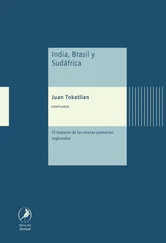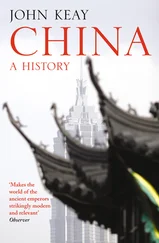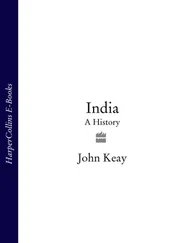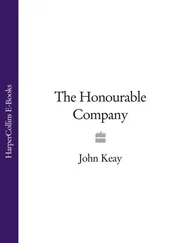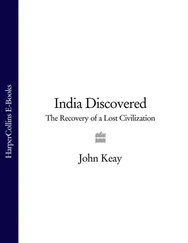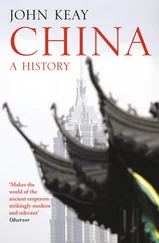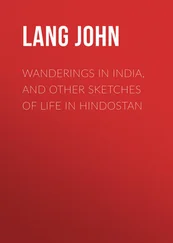Almost everything that is known of these Bactrian Greeks has been surmised from their splendid coins. Minted and die-cast in imitation of Greek practice, they are mostly circular, of silver, often large, and altogether a great advance on the punch-marked lumps of the Mauryas. Considerable hoards as well as individual examples have been found over a vast area; and coinage design being extraordinarily conservative, they provide somewhat the same information as a modern coin. Thus, we learn of the names of these kings, of their preferred titles, and often of the Greek deity with whom they wished to be associated. From the obverse, or ‘heads’ side of the coins, we also know what they looked like and what headgear they sported. Such personal insights are rare; knowing nothing of, for instance, Ashoka’s mien (other than that it was ‘gracious’), we feel personally acquainted with the bull-necked Eucratides and the big-nosed Heliocles. Some wear a curious cap, modelled on an elephant’s skull, with the trunk serving as a peak; others favoured the kausia , like a shallow upturned bowl, of faintly ecclesiastical look; the chinless Amyntas, whose long nose quests from beneath a sun helmet indistinguishable from the British solar topi, must surely have had knobbly knees and worn knee-length white socks. From such portraits information has been drawn about the likely age of a king when he ascended the throne; and blood relationships, indeed the succession, are sometimes premised on resemblances in their physiognomy and headgear. Lacking much in the way of corroborative sources, scholars have pored over every iota of numismatic detail to ingenious but seldom conclusive effect.
A fundamental problem seems to be that of there being rather too many kings for the, at most, 130 years of their involvement in India. It is as if all these Platos and Stratos, Demetriuses and Diodotuses had got wise to the idea that immortality was theirs provided they could but strike their own coins. Scholars meet this problem by proposing that there was usually more than one king and more than one kingdom. The Yavanas had a reputation for quarrelling amongst themselves, and their territories must therefore have frequently been divided and subdivided. As well as rival kings, it seems that sub-kings, joint-kings, expectant-kings and satraps or governors may all have minted their own coins. Where their various territories lay can be vaguely inferred from the find sites of a particular coin-type.
Many clearly never crossed the north-west frontier from Afghanistan, and those who did may not have come as invaders. Perhaps, like other Greeks in Asia, they came bearing gifts. Bactria had grown rich as a corridor of east – west trade and was also an important source of bloodstock. Indians, ever anxious for horses (but blissfully ignorant of the one gifted to Troy), may have welcomed them as both traders and mercenaries. It could be significant that three centuries later, when the Gandhara school of sculpture popularised Greek themes, the Trojan horse seems to have been a favourite.
First of these Indo-Greeks into India was a Demetrius, probably Demetrius II, who seems to have achieved success in the Panjab and to have established himself at Taxila. He may also have continued down the Indus to its mouth. This is thought to have happened some time soon after 180 BC and, from the fact that the legends on his coins are in Prakrit or Kharosthi as well as in Greek, it is clear that he acquired Indian subjects. A successor, Menander, fared even better with mid-century acquisitions to the north in Swat and possibly Kashmir, as well as to the east. How far east is uncertain. He probably extended his territory to the river Ravi, but may have raided much further afield. In Indian sources a Yavana force that was probably Menander’s is said to have joined the kings of Panchala and Mathura (both in the Ganga-Jamuna Doab) for a raid down the Ganga. Perhaps it was this combination of Greeks and Indians that the all-conquering Kharavela of Kalinga encountered. If so, he failed to stop them since, realising Alexander’s dream, they stormed Pataliputra and routed its presumably Shunga incumbent. Then, typically, they quarrelled; maybe Menander, like Alexander, faced a mutiny. ‘They came, they saw, but India conquered,’ writes one of their biographers. 5
On his coins Menander does not have the look of a conqueror. His topi-style helmet appears much too big; protruding curls and delicate features suggest effeminacy; and he calls himself ‘ Basileos ’ and ‘ Soter ’, ‘King’ and ‘Saviour’, rather then ‘Conqueror’ or ‘Patriot’. With this gentler image his other legacy is more in keeping; for in Buddhist tradition he is remembered as ‘Milinda’, the great king who in a celebrated question-and-answer session with the philosopher Nagasena became the vehicle for an exposition of Buddhist doctrine; he may even himself have adopted Buddhism. The meeting took place in Menander’s capital of Sagala, whose whereabouts are uncertain but which may have been in the boulder-strewn valley of Swat. If this surmise is correct, it must be thanks to Menander that the gentle terraces beside the racing river Swat came to accommodate the pre-eminent centre of Buddhist teaching in the north-west.
Of Menander’s successors we know little. One, Antialcidas, is thought to have briefly reunited the Greeks’ territories on either side of the Hindu Kush in around 110 BC. He is mentioned in an inscription on a pillar erected by one Heliodorus in a village in central India hundreds of miles away to the south-east but just fields from Vidisha and the stupas of Sanchi. Heliodorus was Antialcidas’ emissary to a King Bhagabhadra who is otherwise unknown but who may have been one of the Shungas. Perhaps Antialcidas was seeking some kind of alliance against his ever quarrelsome rivals. The memorial is more revealing about ambassador Heliodorus who, though decidedly a Greek and the son of a certain Dion of Taxila, nevertheless describes himself as a devotee of the god Vasudeva. Accordingly he crowned his pillar with an image of the winged Garuda, Vasudeva’s ‘vehicle’. Already associated with both the Greek Heracles and the Yadavas’ Lord Krishna, the heroic Vasudeva was about to become absorbed into the multiple persona of the great Lord Vishnu. Heliodorus thus provides an early example of the adoption by a non-Indian, not of the generally more accessible and proselytising doctrines of the Buddha, but of an orthodox cult within the so-called ‘Great Tradition’ of what we now call Hinduism.
Such cross-cultural adoptions, for which the word ‘conversion’ is still too strong, become commonplace amongst those who in the first century BC supplanted the Bactrian Greeks. On their coins, modelled on those of the Bactrian Greeks, Greek gods are jumbled up with unmistakably Indian deities, amongst whom Lord Shiva and his consort Uma have been identified. Elephants also appear, and kings are often depicted mounted on horseback. The newcomers have unfamiliar names – Maues, Azes, Spalirises; each is typically designated a ‘king of kings’ and, less proud of their profiles, they eschew the close-up portraits so beloved of the Greeks.
Who these people were, when they reigned and where, is still debated. Most authorities believe that Maues, who first displaced the Greeks in the Taxila region, was a Shaka, others that he was a Pahlava. The Pahlavas, it appears, may or may not be the same as the Parthians of northern Iran, just as the Shakas may or may not be the same as the Scythians of the Caucasus. But if Maues and his immediate successors in the first century BC were Shakas, their immediate successors in the first century AD were probably Parthians.
Of one of these Parthians we know from a source other than his coins and the odd inscription. His name was ‘Gondophares’, which, as the French scholar M. Reinaud noticed in the 1860s, bears a more than coincidental resemblance to ‘Gudnaphar’, an Indian king mentioned in an early Christian text. This text was the Acts of St Thomas, wherein the self-same apostle is said to have actually attended the court of King Gudnaphar. Thomas, it seems, had reached the Panjab under protest. After the death of Christ, when the apostles drew lots as to their respective missions, Thomas had drawn India and, ever the ‘doubting Thomas’, immediately knew that the task was beyond him. ‘Whithersoever thou wilt, O Lord, send me,’ he prayed, ‘only to India I will not go.’ But the prayer was of no avail. Thomas, apparently a skilled carpenter, found himself indentured to a passing Indian merchant who took him back to work on Gondophares’ new palace. In the Panjab he was eventually rewarded with honours and converts. Later, he would undertake a second mission to peninsular India, where his misgivings would prove tragically well-founded.
Читать дальше


